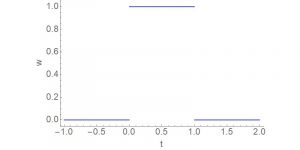To illustrate the effects of studying the frequency content of a signal of finite length, let’s start with a function containing just one single frequency:
\(g\left(t,f_0,\phi ,A\right)=A \sin \left(2 \pi f_0 t+\phi \right)\)
With the Fourier transform defined as
\(G(\omega )=\frac{1}{\sqrt{2 \pi }} \int_{-\infty }^{\infty } g(t) e^{i t \omega } \, dt\) and \(\omega = 2 \pi f \), the Fourier transform of \(g\) is
\(G\left(f,f_0,\phi ,A\right)=\frac{i A e^{-i \phi } \delta \left(f-f_0\right)}{2 \sqrt{2 \pi }}-\frac{i A e^{i \phi } \delta \left(f+f_0\right)}{2 \sqrt{2 \pi }}\)
So you get exactly what you generally expect: If the signal is a sinus, resulting in a sprectrum with a line at the frequency of the sinus, and one at minus the frequency.
Now, what happens if you can only see a finite part of the spectrum? One way looking at this is by assuming that the signal is zero outside of the window that can be seen.
Let’s assume a window function \(w(t,T)=\theta (x) \theta (T-x)\) that is \(1\) from \(0\) to \(T\), and \(0\) everywhere else. The plot shows the window with \(T=1\)

\(\frac{\theta (T) \left(e^{i T \omega } (-2 \pi f \cos (2 \pi f T+\phi )+i \omega \sin (2 \pi f T+\phi
))+2 \pi f \cos (\phi )-i \omega \sin (\phi )\right)}{\sqrt{2 \pi } \left(4 \pi ^2 f^2-\omega
^2\right)}\)

